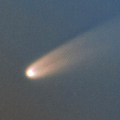
|
Appearing in the morning sky in the Northern Hemisphere. Now it is very bright as 0.8 mag (July 3, Nicolas Biver). It turns to be in the evening sky after this, and it stays observable while getting fainter. In the Southern Hemisphere, it will appear in the evening sky at 5 mag in late July.
Date(TT) R.A. (2000) Decl. Delta r Elong. m1 Best Time(A, h)
July 4 6 0.30 30 50.8 1.143 0.295 14 0.9 5:38 (241,-12)
July 11 6 44.54 41 52.4 0.898 0.372 21 1.6 5:37 (233,-21)
|
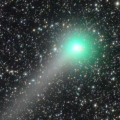
|
Now it is very bright as 7.0 mag (July 1, Willian Souza). It will be fading after this. It stays observable in good condition for a long time after this.
Date(TT) R.A. (2000) Decl. Delta r Elong. m1 Best Time(A, h)
July 4 10 46.98 0 21.6 0.836 0.954 61 6.8 18:30 (127, 40)
July 11 11 34.42 6 0.0 0.879 0.996 62 7.4 18:33 (136, 38)
|
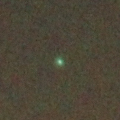
|
Now it is bright as 7.3 mag (June 30, Chris Wyatt). In the Southern Hemisphere, it stays observable in good condition in the evening sky while the comet will be fading. In the Northern Hemisphere, it is not observable until mid August when the comet will fade down to 12 mag.
Date(TT) R.A. (2000) Decl. Delta r Elong. m1 Best Time(A, h)
July 4 8 25.43 15 7.9 0.974 0.401 23 7.5 18:30 (112, 5)
July 11 9 13.97 8 19.3 0.816 0.516 30 7.8 18:33 (109, 12)
|
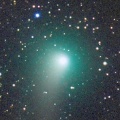
|
Now it is 9.7 mag (June 30, Chris Wyatt). It stays observable at 9-10 mag in the evening sky until September.
Date(TT) R.A. (2000) Decl. Delta r Elong. m1 Best Time(A, h)
July 4 12 37.08 39 17.3 1.822 1.804 72 8.7 18:30 (171, 15)
July 11 12 50.98 33 56.4 1.893 1.847 71 8.9 18:33 (167, 20)
|
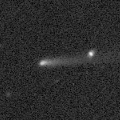
|
Now it is 12.5-13.0 mag (July 5 Michael Jager). It was expected to brighten rapidly up to 9.5 mag in June. But actually, it is fainter than predicted. However, it became very bright as 7.5 mag in SOHO spacecraft images on June 19 (Karl Battams). It is observable in good condition after this while the comet will be fading.
Date(TT) R.A. (2000) Decl. Delta r Elong. m1 Best Time(A, h)
July 4 4 53.67 28 32.3 0.709 0.507 27 10.0 5:38 (234, 0)
July 11 4 56.96 27 56.6 0.851 0.557 33 11.1 5:37 (231, 5)
|
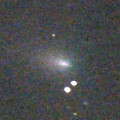
|
Recovered from SWAN images after 24-year blank. Now it is 11.9 mag (July 2, Chris Wyatt). It stays 10-11 mag until August. In the Southern Hemisphere, it stays observable in the morning sky for a long time. In the Northern Hemisphere, it stays very low until July.
Date(TT) R.A. (2000) Decl. Delta r Elong. m1 Best Time(A, h)
July 4 3 47.41 12 33.1 1.971 1.448 45 10.5 5:38 (234, 23)
July 11 4 8.69 12 57.8 1.972 1.475 46 10.7 5:37 (233, 23)
|
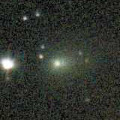
|
Now it is 11.6 mag (June 21, Paul Camilleri). Brightening very rapidly. It will brighten up to 8-9 mag from summer to autumn. It will be observable in excellent condition in the Southern Hemisphere. It locates very low around the high light in the Northern Hemisphere.
Date(TT) R.A. (2000) Decl. Delta r Elong. m1 Best Time(A, h)
July 4 12 59.25 -6 4.6 1.210 1.631 93 11.0 18:30 (169, 61)
July 11 13 8.46 -7 26.8 1.230 1.592 89 10.8 18:33 (158, 61)
|
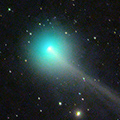
|
It brightened up to 4.7 mag in early May (May 2, Marco Goiato). However, it is fading and getting diffused after that. It has already faded down to 7.3 mag (May 21, Mitsunori Tsumura). It is not observable until August after this.
Date(TT) R.A. (2000) Decl. Delta r Elong. m1 Best Time(A, h)
July 4 6 18.71 30 12.9 1.962 0.981 10 12.1 5:38 (244,-15)
July 11 6 25.02 27 45.6 2.067 1.109 14 12.7 5:37 (243,-10)
|
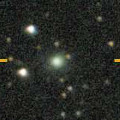
|
Now it is 14.0 mag (June 25, Thomas Lehmann). It is expected to brighten up to 10.5 mag from December to January. In the Northern Hemisphere, it stays observable in good condition while the comet will be brightening gradually, but it is not observable at the high light. In the Southern Hemisphere, it is not observable for a long time, but it will be observable in good condition after the high light. It is fainter than this ephemeris recently.
Date(TT) R.A. (2000) Decl. Delta r Elong. m1 Best Time(A, h)
July 4 11 57.36 54 55.5 2.841 2.556 63 12.8 18:30 (168, -1)
July 11 11 58.86 51 10.2 2.841 2.495 60 12.7 18:33 (163, 1)
|
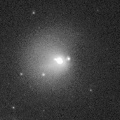
|
Now it is not visible, fainter than 14.0 mag (July 2, Chris Wyatt).
Date(TT) R.A. (2000) Decl. Delta r Elong. m1 Best Time(A, h)
July 4 2 34.08 24 10.0 6.271 5.811 58 13.7 5:38 (212, 23)
July 11 2 37.99 24 36.6 6.178 5.812 64 13.7 5:37 (206, 25)
|

|
Now it is 13.6 mag (June 13, Thomas Lehmann). It stays 14 mag until autumn. In the Southern Hemisphere, it will never be observable again.
Date(TT) R.A. (2000) Decl. Delta r Elong. m1 Best Time(A, h)
July 4 3 59.15 82 10.8 4.231 3.852 61 14.1 5:38 (187,-30)
July 11 5 2.55 83 59.3 4.244 3.890 63 14.2 5:37 (186,-32)
|
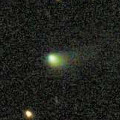
|
Now it is 14.0 mag (June 21, Paul Camilleri). It stays 13-14 mag from 2020 to 2021. It stays observable in good condition for a while.
Date(TT) R.A. (2000) Decl. Delta r Elong. m1 Best Time(A, h)
July 4 12 42.61 9 48.2 3.061 3.120 83 14.3 18:30 (167, 44)
July 11 12 47.38 8 37.2 3.138 3.106 78 14.3 18:33 (158, 44)
|
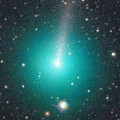
|
It brightened up to 8 mag from March to April. It continued brightening for a while even after the perihelion passage on Mar. 15. But it is fading now. It has already faded down to 13.6 mag (June 21, Paul Camilleri). It seems to be a fragment of C/1988 A1 (Liller), like C/1996 Q1 (Tabur) and C/2015 F3 (SWAN).
Date(TT) R.A. (2000) Decl. Delta r Elong. m1 Best Time(A, h)
July 4 12 12.01 21 39.9 2.073 2.021 72 14.4 18:30 (161, 31)
July 11 12 19.11 17 59.4 2.246 2.112 69 15.0 18:33 (154, 33)
|
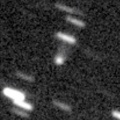
|
Now it is 15.0 mag (June 16, Toshihiko Ikemura, Hirohisa Sato). It will brighten up to 13 mag in 2021. In 2020, it is observable at 15 mag in good condition from spring to summer.
Date(TT) R.A. (2000) Decl. Delta r Elong. m1 Best Time(A, h)
July 4 13 51.98 -22 47.7 4.298 4.766 111 14.9 19:01 (180, 78)
July 11 13 50.83 -23 12.0 4.364 4.727 104 14.9 18:33 (179, 78)
|
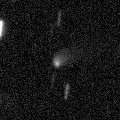
|
Now it is 15.5 mag (June 6, iTelescope Observatory, Siding Spring). It stays 14-15 mag until 2021. In the Southern Hemisphere, it stays observable in good condition for a long time. In the Northern Hemisphere, it is not observable until June in 2021.
Date(TT) R.A. (2000) Decl. Delta r Elong. m1 Best Time(A, h)
July 4 14 29.27 -82 44.1 4.306 4.834 115 15.0 19:40 ( 0, 42)
July 11 14 29.84 -82 2.0 4.302 4.809 114 15.0 19:13 ( 0, 43)
|
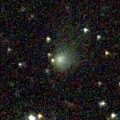
|
Now it is 15.1 mag (June 24, Martin Masek). It is expected to be observable at 5-6 mag for a long time from 2022 to 2023. In the Northern Hemisphere, it is not observable at the high light from 2022 summer to 2023 summer. In the Southern Hemisphere, it is only visible in the extremely low sky in summer in 2020. But it will be observable in good condition at the high light.
Date(TT) R.A. (2000) Decl. Delta r Elong. m1 Best Time(A, h)
July 4 17 30.61 52 45.2 8.531 8.803 102 15.1 22:38 (180, 2)
July 11 17 25.79 52 19.5 8.494 8.752 101 15.1 22:06 (180, 3)
|
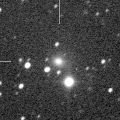
|
Now it is 15.8 mag (June 14, SONEAR Observatory, Oliveira). It stays 15 mag until summer. It stays observable for a long time in the Southern Hemisphere. It is not observable until August in the Northern Hemisphere.
Date(TT) R.A. (2000) Decl. Delta r Elong. m1 Best Time(A, h)
July 4 3 20.62 -34 52.6 4.064 3.955 76 15.2 5:38 (283, 55)
July 11 3 22.85 -34 49.5 4.029 3.986 80 15.2 5:37 (280, 60)
|

|
Now it is very faint as 18-19 mag (June 16, Alan Hale). It was expected to brighten very rapidly, and brighten up to 14.5 mag from August to September. But actually, it is much fainter than predicted. However, Thomas Lehmann reported it is bright as 15.3 mag on June 25. In the Northern Hemisphere, it stays observable for a long time, although it becomes extremely low in early September. In the Southern Hemisphere, it is not observable until late October.
Date(TT) R.A. (2000) Decl. Delta r Elong. m1 Best Time(A, h)
July 4 23 23.62 69 56.7 1.160 1.342 75 15.6 4:34 (180,-15)
July 11 0 13.08 80 32.3 1.152 1.264 70 15.3 4:55 (180,-25)
|
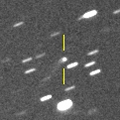
|
Now it is 15.1 mag (June 15, Toshihiko Ikemura, Hirohisa Sato). It stays 15-16 mag for a long time until 2021.
Date(TT) R.A. (2000) Decl. Delta r Elong. m1 Best Time(A, h)
July 4 19 59.92 16 20.6 3.675 4.477 137 15.3 1:12 (180, 39)
July 11 19 50.09 17 23.9 3.654 4.479 139 15.3 0:35 (180, 38)
|
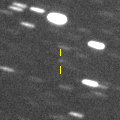
|
Now it is 15.5 mag (June 24, Martin Masek). It will brighten up to 15-16 mag from June to August, and it will be observable in good condition.
Date(TT) R.A. (2000) Decl. Delta r Elong. m1 Best Time(A, h)
July 4 19 20.04 -0 57.1 1.094 2.069 157 15.4 0:32 (180, 56)
July 11 19 17.05 -1 18.1 1.081 2.063 159 15.4 0:02 (180, 56)
|

|
Now it is 16.1 mag (June 15, P. Camilleri, H. Williams, M. Al-Bussadi). It will brighten up to 13.5 mag in spring in 2021. In the Southern Hemisphere, it stays observable in good condition for a long time. In the Northern Hemisphere, it is not observable until spring in 2021.
Date(TT) R.A. (2000) Decl. Delta r Elong. m1 Best Time(A, h)
July 4 21 36.53 -62 50.2 3.531 4.274 131 15.5 2:50 ( 0, 62)
July 11 21 13.03 -64 22.8 3.467 4.236 133 15.5 1:59 ( 0, 61)
|
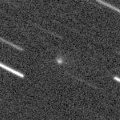
|
Now it is 17.3 mag (July 1, ATLAS-HKO, Haleakala). Small comet. But it will approach to Sun down to 0.47 a.u. in September, and it is expected to brighten up to 11 mag. It stays observable in good condition until late August while the comet will be brightening up to 11 mag.
Date(TT) R.A. (2000) Decl. Delta r Elong. m1 Best Time(A, h)
July 4 0 17.78 25 13.8 1.241 1.574 87 16.4 5:29 (180, 30)
July 11 0 43.43 27 21.0 1.085 1.460 87 15.8 5:27 (180, 28)
|
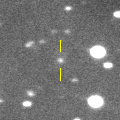
|
Now it is 15.3 mag (June 15, Toshihiko Ikemura, Hirohisa Sato). It will brighten up to 12 mag in winter in 2022. In the Northern Hemisphere, it stays observable in good condition for a long time. In the Southern Hemisphere, it is not observable until 2021 November.
Date(TT) R.A. (2000) Decl. Delta r Elong. m1 Best Time(A, h)
July 4 0 45.47 56 10.5 6.189 5.957 72 15.9 5:38 (183, -1)
July 11 0 48.98 57 13.4 6.079 5.913 75 15.8 5:33 (180, -2)
|
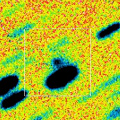
|
Now it is 16.1 mag (June 29, ATLAS-HKO, Haleakala). It brightens up to 13.5 mag in winter. But it is not observable at high light. In the Southern Hemisphere, it stays observable in good condition until autumn when the comet will brighten up to 14 mag. It stays locating very low in the Northern Hemisphere.
Date(TT) R.A. (2000) Decl. Delta r Elong. m1 Best Time(A, h)
July 4 18 21.70 -46 34.2 1.724 2.683 155 16.2 23:30 ( 0, 78)
July 11 18 13.49 -45 57.5 1.711 2.654 152 16.0 22:54 ( 0, 79)
|
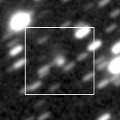
|
Now it is 16.4 mag (June 19, Katsumi Yoshimoto). It will stay at 15 mag for a long time from 2021 to 2022. In the Northern Hemisphere, it stays observable in good condition while brightening gradually. In the Southern Hemisphere, it stays locating low for a long time.
Date(TT) R.A. (2000) Decl. Delta r Elong. m1 Best Time(A, h)
July 4 18 15.10 32 45.9 5.578 6.199 123 16.2 23:23 (180, 22)
July 11 18 8.20 31 59.6 5.555 6.169 123 16.1 22:48 (180, 23)
|
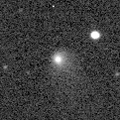
|
It brightened up to 13.8 mag in autumn in 2019 (Sept. 3, Chris Wyatt). Now it is fading slowly. Now it is 16.0 mag (June 20, Toshihiko Ikemura, Hirohisa Sato). In 2020, it stays observable in good condition while the comet will be fading from 16 to 17 mag.
Date(TT) R.A. (2000) Decl. Delta r Elong. m1 Best Time(A, h)
July 4 0 40.34 -0 34.7 5.687 5.832 93 16.4 5:38 (186, 55)
July 11 0 40.20 -0 10.3 5.615 5.872 99 16.4 5:24 (180, 55)
|
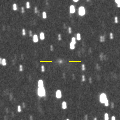
|
Now it is 17.1 mag (June 19, Toshihiko Ikemura, Hirohisa Sato). It will brighten up to 16.5 mag and will be observable in good condition from June to October.
Date(TT) R.A. (2000) Decl. Delta r Elong. m1 Best Time(A, h)
July 4 20 34.63 16 7.4 1.377 2.206 133 16.6 1:46 (180, 39)
July 11 20 32.42 16 52.4 1.336 2.194 137 16.5 1:17 (180, 38)
|

|
It brightened up to 13.2 mag from spring to autumn in 2019 (June 30, Thomas Lehmann). Now it is fading slowly. It has already faded down to 16.3 mag (June 7, ATLAS-MLO, Mauna Loa). In the Southern Hemisphere, it stays observable for a long time. In the Northern Hemisphere, it stays low for a long time.
Date(TT) R.A. (2000) Decl. Delta r Elong. m1 Best Time(A, h)
July 4 0 5.47 -30 18.8 3.796 4.269 111 16.6 5:17 (180, 85)
July 11 0 1.52 -30 26.4 3.740 4.308 117 16.6 4:45 (180, 85)
|
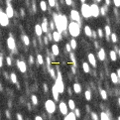
|
Now it is 16.7 mag (July 1, ATLAS-HKO, Haleakala). It will be observable at 16.5-17 mag from spring in 2020 to summer in 2021.
Date(TT) R.A. (2000) Decl. Delta r Elong. m1 Best Time(A, h)
July 4 18 35.00 22 0.7 3.963 4.736 134 16.6 23:42 (180, 33)
July 11 18 24.29 21 0.4 3.954 4.725 134 16.6 23:04 (180, 34)
|

|
Now it is 15.1 mag (June 23, ATLAS-MLO, Mauna Loa). It is observable at 16 mag in 2020. It is observable in excellent condition in the Southern Hemisphere. It locates somewhat low in the Northern Hemisphere.
Date(TT) R.A. (2000) Decl. Delta r Elong. m1 Best Time(A, h)
July 4 19 3.56 -29 18.2 5.712 6.723 173 16.6 0:16 (180, 84)
July 11 18 55.64 -29 5.1 5.731 6.737 170 16.6 23:36 (180, 84)
|

|
Now it is 17.7 mag (June 13, J. L. Virlichie, P. Traverse). It brightens up to 16 mag from summer to winter. In the Southern Hemisphere, it is observable in excellent condition. In the Northern Hemisphere, it is not observable until late October.
Date(TT) R.A. (2000) Decl. Delta r Elong. m1 Best Time(A, h)
July 4 22 27.27 -61 40.4 1.312 2.088 127 17.0 3:39 ( 0, 63)
July 11 22 30.47 -63 37.2 1.249 2.039 128 16.8 3:15 ( 0, 62)
|
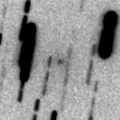
|
Now it is 17.3 mag (June 15, Toshihiko Ikemura, Hirohisa Sato). It brightens up to 17 mag from June to July. It is observable in excellent condition in the Northern Hemisphere. In the Southern Hemisphere, it is not observable until August.
Date(TT) R.A. (2000) Decl. Delta r Elong. m1 Best Time(A, h)
July 4 20 52.21 66 23.7 1.352 1.662 87 16.9 2:07 (180,-11)
July 11 19 7.20 66 32.9 1.328 1.691 91 16.9 23:38 (180,-11)
|
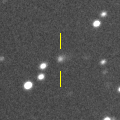
|
Now it is 16.8 mag (June 10, ATLAS-HKO, Haleakala). It stays observable at 16-17 mag from 2020 to 2021. It locates somewhat low in the Northern Hemisphere.
Date(TT) R.A. (2000) Decl. Delta r Elong. m1 Best Time(A, h)
July 4 11 3.27 -15 5.0 6.836 6.593 72 16.9 18:30 (114, 53)
July 11 11 7.45 -14 55.6 6.935 6.596 66 16.9 18:33 (108, 48)
|

|
Now it is 18.0 mag (June 11, ATLAS-MLO, Mauna Loa). It stays observable at 16-17 mag for a long time until 2024.
Date(TT) R.A. (2000) Decl. Delta r Elong. m1 Best Time(A, h)
July 4 15 33.20 -15 34.0 9.080 9.796 132 17.2 20:42 (180, 71)
July 11 15 30.09 -15 19.5 9.159 9.779 125 17.2 20:11 (180, 70)
|

|
Now it is 17.4 mag (June 19, Katsumi Yoshimoto). It will brighten up to 14.5 mag from spring to summer in 2021. In the Southern Hemisphere, it stays observable in excellent condition for a long time. In the Northern Hemisphere, it is observable in good condition in 2020, however, it will be unobservable in 2021.
Date(TT) R.A. (2000) Decl. Delta r Elong. m1 Best Time(A, h)
July 4 23 19.80 8 23.4 3.541 3.970 107 17.3 4:31 (180, 46)
July 11 23 17.19 7 21.7 3.378 3.921 115 17.2 4:01 (180, 47)
|

|
It will pass the perihelion in 2021, and it is predicted to be observable at 17-18 mag from 2020 to 2022. However, it has not been observed at all since 2015. It was not detected, fainter than 20.5 mag, in 2017 May (Werner Hasubick).
Date(TT) R.A. (2000) Decl. Delta r Elong. m1 Best Time(A, h)
July 4 20 35.22 -22 6.1 5.025 5.970 156 17.3 1:47 (180, 77)
July 11 20 32.80 -22 11.7 4.977 5.959 163 17.2 1:17 (180, 77)
|
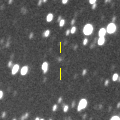
|
Now it is 17.0 mag (June 23, A. Diepvens). It will be observable at 16.5-17 mag from 2020 to 2021. In the Southern Hemisphere, it is not observable until summer in 2021.
Date(TT) R.A. (2000) Decl. Delta r Elong. m1 Best Time(A, h)
July 4 2 3.65 70 36.6 6.585 6.184 62 17.3 5:38 (188,-17)
July 11 2 0.91 71 15.7 6.514 6.171 65 17.3 5:37 (186,-17)
|
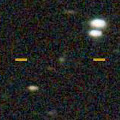
|
Now it is 17.1 mag (June 10, ATLAS-HKO, Haleakala). It became brighter than orignally predicted. It stays observable at 17 mag in good condition until autumn.
Date(TT) R.A. (2000) Decl. Delta r Elong. m1 Best Time(A, h)
July 4 13 1.98 -11 7.1 1.794 2.157 96 17.3 18:30 (169, 66)
July 11 13 10.08 -12 4.9 1.855 2.144 91 17.3 18:33 (155, 65)
|
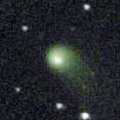
|
It brightened up to 12-13 mag from 2018 to 2019. Now it is fading. It has already faded down to 17.0 mag (June 15, P. Camilleri, H. Williams, M. Al-Bussadi). In the Southern Hemisphere, it stays observable in good condition for a long time. It will never be observable after this in the Northern Hemisphere.
Date(TT) R.A. (2000) Decl. Delta r Elong. m1 Best Time(A, h)
July 4 9 23.86 -58 9.8 5.733 5.768 86 17.4 18:30 ( 40, 45)
July 11 9 27.48 -57 31.7 5.835 5.815 83 17.5 18:33 ( 41, 41)
|

|
First return of a new periodic comet which brightened up to 17.5 mag in 2012. Now it is 17.6 mag (June 30, Hidetaka Sato). It stays observable at 17 mag in good condition from summer to winter. It locates somewhat low in the Southern Hemisphere.
Date(TT) R.A. (2000) Decl. Delta r Elong. m1 Best Time(A, h)
July 4 3 0.28 20 12.4 2.726 2.279 53 17.5 5:38 (220, 24)
July 11 3 13.13 21 30.6 2.666 2.282 57 17.5 5:37 (216, 24)
|
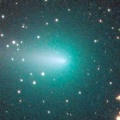
|
Fragment of C/1844 Y1 (Great Comet). It brightened up to 7.0 mag in late March ((Mar. 30, Charles S. Morris). But the nucleus was split into some fragments, and it faded out after that. It was 9.1 mag in mid May (May 17, Sandor Szabo). It approached to Sun down to 0.25 a.u. on May 31. In the Northern Hemisphere, it is not observable after this. In the Southern Hemisphere, it is appearing in the morning sky, but it locates extremely low.
Date(TT) R.A. (2000) Decl. Delta r Elong. m1 Best Time(A, h)
July 4 5 47.54 3 5.2 1.777 0.962 25 17.6 5:38 (262, 6)
July 11 6 4.30 2 35.0 1.910 1.107 27 18.3 5:37 (261, 9)
|
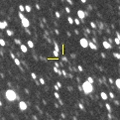
|
Sam Deen pointed out that it brightened in outburst twice in 2017 and 2019. It was observed at 20-21 mag in 2017. Then it became fainter than 22.9 mag in 2018 summer (Aug. 29, Sam Deen). However, it brightened up to 17.2 mag in 2019 spring (Mar. 25, B. T. Bolin). Then it is fading again after that. Now it is 19.9 mag (May 29, Toshihiko Ikemura, Hirohisa Sato). It is predicted to stay observable at 18 mag for a long time from 2019 to 2021. But actually, it is much fainter than this ephemeris.
Date(TT) R.A. (2000) Decl. Delta r Elong. m1 Best Time(A, h)
July 4 18 52.23 -21 10.6 6.689 7.705 178 17.6 0:05 (180, 76)
July 11 18 48.40 -21 46.7 6.700 7.709 172 17.6 23:29 (180, 77)
|

|
Now it is 16.7 mag (June 13, Toshiyuki Takahashi). It will brighten up to 15.5 mag in early 2021. In 2020, it stays observable at 17 mag until November in the Southern Hemisphere, or until July in the Northern Hemisphere.
Date(TT) R.A. (2000) Decl. Delta r Elong. m1 Best Time(A, h)
July 4 13 57.87 -29 34.5 2.563 3.126 114 17.6 19:07 (180, 85)
July 11 13 58.47 -29 12.5 2.597 3.070 108 17.7 18:40 (180, 84)
|

|
Now it is 18.6 mag (June 27, ATLAS-MLO, Mauna Loa). It is expected to brighten up to 15 mag from October to November, and it will be observable in excellent condition.
Date(TT) R.A. (2000) Decl. Delta r Elong. m1 Best Time(A, h)
July 4 23 33.93 -32 8.8 1.305 1.996 118 17.9 4:45 (180, 87)
July 11 23 43.34 -32 38.4 1.208 1.946 121 17.7 4:27 (180, 88)
|
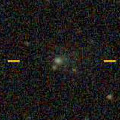
|
Now it is 17.8 mag (June 14, Charles S. Morris). It will fade out after this, and will be fainter than 18 mag in July.
Date(TT) R.A. (2000) Decl. Delta r Elong. m1 Best Time(A, h)
July 4 13 16.02 -5 34.7 1.756 2.140 97 17.7 18:30 (178, 61)
July 11 13 25.35 -6 30.6 1.837 2.150 93 17.8 18:33 (167, 61)
|

|
Now it is 17.4 mag (June 24, Martin Masek). It will be fading slowly after this. It is observable in good condition in the Northern Hemisphere. In the Southern Hemisphere, it is observable in the extremely low sky only in 2021 spring.
Date(TT) R.A. (2000) Decl. Delta r Elong. m1 Best Time(A, h)
July 4 12 38.62 47 44.6 9.211 8.931 70 17.7 18:30 (173, 7)
July 11 12 40.01 46 51.5 9.291 8.944 67 17.7 18:33 (168, 7)
|
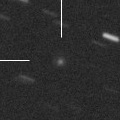
|
It brigthened up to 16.5 mag in May (May 14, R. Ligustir). It is fading rapidly after that. It has already faded down to 18.8 mag (June 16, Toshihiko Ikemura, Hirohisa Sato).
Date(TT) R.A. (2000) Decl. Delta r Elong. m1 Best Time(A, h)
July 4 14 56.75 -1 47.5 3.199 3.797 119 17.7 20:06 (180, 57)
July 11 14 55.94 -2 48.0 3.323 3.834 112 17.8 19:37 (180, 58)
|
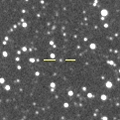
|
Now it is 17.5 mag (June 1, ATLAS-MLO, Mauna Loa). It is observable at 17-18 mag in good condition in 2020 summer.
Date(TT) R.A. (2000) Decl. Delta r Elong. m1 Best Time(A, h)
July 4 19 35.71 31 11.4 8.313 8.934 124 17.8 0:48 (180, 24)
July 11 19 31.57 31 34.0 8.289 8.928 126 17.8 0:16 (180, 23)
|
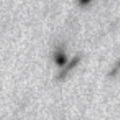
|
Now it is 18.6 mag (May 30, ATLAS-MLO, Mauna Loa). It stays 18-19 mag for a long time from 2018 to 2020.
Date(TT) R.A. (2000) Decl. Delta r Elong. m1 Best Time(A, h)
July 4 20 55.58 -34 44.5 3.636 4.551 150 17.9 2:08 (180, 90)
July 11 20 50.90 -34 46.8 3.604 4.556 156 17.9 1:36 (180, 90)
|

|
It has not been observed yet in this apparition. It will brighten up to 17.5 mag in autumn. It is observable in excellent condition in the Southern Hemisphere. It locates very low in the Northern Hemisphere.
Date(TT) R.A. (2000) Decl. Delta r Elong. m1 Best Time(A, h)
July 4 23 26.21 -19 6.0 2.584 3.174 116 18.0 4:38 (180, 74)
July 11 23 29.18 -20 17.1 2.501 3.168 122 17.9 4:13 (180, 75)
|
|
![]()
 C/2019 K7 ( Smith )
C/2019 K7 ( Smith ) 115P/Maury
115P/Maury C/2020 J1 ( SONEAR )
C/2020 J1 ( SONEAR ) C/2020 K8 ( Catalina-ATLAS )
C/2020 K8 ( Catalina-ATLAS ) C/2019 L3 ( ATLAS )
C/2019 L3 ( ATLAS ) 17P/Holmes
17P/Holmes C/2018 U1 ( Lemmon )
C/2018 U1 ( Lemmon ) C/2017 B3 ( LINEAR )
C/2017 B3 ( LINEAR ) 257P/Catalina
257P/Catalina C/2018 A6 ( Gibbs )
C/2018 A6 ( Gibbs ) C/2017 Y2 ( PanSTARRS )
C/2017 Y2 ( PanSTARRS ) C/2017 U7 ( PanSTARRS )
C/2017 U7 ( PanSTARRS ) 162P/Siding Spring
162P/Siding Spring C/2020 K3 ( Leonard )
C/2020 K3 ( Leonard ) C/2019 C1 ( ATLAS )
C/2019 C1 ( ATLAS ) C/2020 F2 ( ATLAS )
C/2020 F2 ( ATLAS ) C/2019 T2 ( Lemmon )
C/2019 T2 ( Lemmon ) C/2014 F3 ( Sheppard-Trujillo )
C/2014 F3 ( Sheppard-Trujillo ) C/2019 T3 ( ATLAS )
C/2019 T3 ( ATLAS ) 278P/McNaught
278P/McNaught C/2017 M4 ( ATLAS )
C/2017 M4 ( ATLAS ) P/2020 M2 ( Lemmon )
P/2020 M2 ( Lemmon ) C/2019 Y4 ( ATLAS )
C/2019 Y4 ( ATLAS ) C/2017 K5 ( PanSTARRS )
C/2017 K5 ( PanSTARRS ) 28P/Neujmin 1
28P/Neujmin 1 156P/Russell-LINEAR
156P/Russell-LINEAR 87P/Bus
87P/Bus C/2010 U3 ( Boattini )
C/2010 U3 ( Boattini ) P/2019 LM4 ( Palomar )
P/2019 LM4 ( Palomar ) A/2019 O3
A/2019 O3 186P/Garradd
186P/Garradd 254P/McNaught
254P/McNaught![]()








































